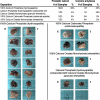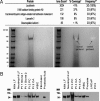Acute inflammatory proteins constitute the organic matrix of prostatic corpora amylacea and calculi in men with prostate cancer
- PMID: 19202053
- PMCID: PMC2651291
- DOI: 10.1073/pnas.0810473106
Acute inflammatory proteins constitute the organic matrix of prostatic corpora amylacea and calculi in men with prostate cancer
Abstract
Corpora amylacea (CA) are a frequent microscopic finding in radical prostatectomy specimens from men undergoing treatment for prostate cancer. Although often observed histologically to be associated with inflammation, the contribution of CA to prostatitis-related symptoms of unknown etiology or to prostate carcinogenesis remains unclear. Prostatic calculi (PC), which potentially represent calcified forms of CA, are less common but can cause urological disease including urinary retention and prostatitis. We conducted a comprehensive compositional analysis of CA/PC to gain insight into their biogenesis. Infrared spectroscopy analysis of calculi collected from 23 patients confirmed a prevalence of calcium phosphate in the form of hydroxyapatite. This result sets PC apart from most urinary stones, which largely are composed of calcium oxalate. Tandem mass spectrometry-based proteomic analysis of CA/PC revealed that lactoferrin is the predominant protein component, a result that was confirmed by Western blot analysis. Other proteins identified, including calprotectin, myeloperoxidase, and alpha-defensins, are proteins contained in neutrophil granules. Immunohistochemistry (IHC) suggested the source of lactoferrin to be prostate-infiltrating neutrophils as well as inflamed prostate epithelium; however, IHC for calprotectin suggested prostate-infiltrating neutrophils as a major source of the protein, because it was absent from other prostate compartments. This study represents a definitive analysis of the protein composition of prostatic CA and calculi and suggests that acute inflammation has a role in their biogenesis--an intriguing finding, given the prevalence of CA in prostatectomy specimens and the hypothesized role for inflammation in prostate carcinogenesis.
Conflict of interest statement
The authors declare no conflict of interest.
Figures





References
-
- Thompson SH. The Diseases of the Prostate: Their Pathology and Treatment. London: J. & A. Churchill; 1883.
-
- Shah SK, Chau MH, Schnepper GD, Lui PD. Open prostatolithotomy for the management of giant prostatic calculi. Urology. 2007;70:1008.e1009–1010. - PubMed
-
- Moore RA. Morphology of prostatic corpora amylacea and calculi. Arch Pathol. 1936;22:24–40.
-
- Bedir S, et al. Endoscopic treatment of multiple prostatic calculi causing urinary retention. International Journal of Urology. 2005;12:693–695. - PubMed
Publication types
MeSH terms
Substances
Grants and funding
LinkOut - more resources
Full Text Sources
Medical
Molecular Biology Databases
Research Materials

